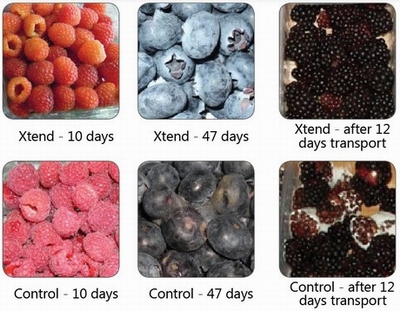Decay by Botrytis and Rhizopus are by far the greatest cause of postharvest losses. Decay can be controlled by prompt cooling, but in addition, since berries tolerate elevated CO2 concentrations of as high as 15%, a concentration at which a substantial fungistatic effect can be achieved, modified and controlled atmosphere are suitable and commonly used means for controlling decay. The unique blend of polymers used in Xtend packaging allows for the development of such fungistatic CO2 concentrations within the packaging environment, which contributes significantly to inhibiting decay causing microorganisms such as Botrytis and prolonging storability of berries. The elevated CO2 concentrations coupled with low O2 concentrations in Xtend packaging also slow down respiration and aging processes.

Maintenance of 90-95% relative humidity at steady state in the Xtend packaging environment also minimizes water loss that causes fruit shriveling and loss of gloss.
The combined effect of elevated CO2, reduced O2 and a humidity of 90-95% in the Xtend packaging environment is:
• Less dehydration and weight loss
• Less shriveling and loss of glossy appearance
• Delayed color development and softening
• Less decay
The packaging performance is as for all MAP solutions highly dependent on proper postharvest handling.
The following postharvest protocols and recommendations should be followed:
1. Postharvest Handling
• Berries should be field packed in punnets and placed in ventilated plastic crates
• Transport the fruit to the packing house as soon as possible after harvesting. Berries should be kept in the shade whilst awaiting transport to the packing house.
2. Upon arrive at the packing house
• Berries should be at least partially precooled to ~70C by Forced Air Cooling with humidification to prevent produce dehydration.
3. Packing in Xtend®
• Pack at as low a temperature as feasibly possible. Avoid increasing temperature of partially cooled fruit.
• Place the Xtend® bag in the packing carton and spread it against the walls. Use well ventilated cartons with venting holes on all sides
• Insert punnets
• Evacuate excess air with hands
• Gather the edges of the bag and twist firmly. Fold over the twisted tip of the bag to form a “J”-like shape
• Apply a rubber band on the “J”-like twisted tip and seal tightly so that air will not escape from the bag
4. Cooling
• Force-air cool to 0-10C (32-34÷F). There is no need for humidification at this stage as the produce is sealed in bags which will prevent dehydration
5. Cold chain management
• Maintain temperatures of 0-10C throughout the supply chain.
• StePac is gaining experience with Xtend® bulk packaging for blueberries in shipments from South America to Europe. Xtend® packaging for raspberries is used for prolonging storage in mainland Europe, whilst Xtend packaging for blackberries is used for shipping from Central to North America.





